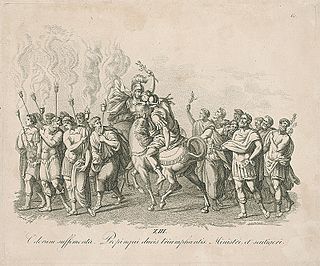Related Research Articles
Gaius Julius Severus was a Roman senator and aristocrat of the second century. He was suffect consul around the year 138.
Gaius Avidius Nigrinus was a Roman senator who lived between the 1st and 2nd centuries. Nigrinus served as suffect consul for the nundinium of April to June 110 with Tiberius Julius Aquila Polemaeanus as his colleague.
Sextus Vettulenus Cerialis was a Roman senator and military commander, the 1st legate of Judaea. He was an early supporter of Vespasian, who appointed Cerialis suffect consul in either 72 or 73.
Gaius Antius Aulus Julius Quadratus was a Roman senator from Pergamon, who was appointed consul twice, in AD 94 and then in AD 105, the first senator from the Eastern Mediterranean to achieve the ordinary consulship.
Tiberius Julius Candidus Marius Celsus was a Roman senator who lived during the Flavian dynasty. Contemporary sources, such as the Fasti Ostienses, the Acta Arvalia and a letter of Pliny the Younger, refer to him as Tiberius Julius Candidus. He was twice consul.
Titus Prifernius Geminus was a Roman senator who lived in the second century. He is best known as a friend and correspondent of Pliny the Younger, who addresses him as Geminus; he served as quaestor to Pliny for the latter's consulship in AD 100, and five letters Pliny wrote to Geminus have survived. Although the letters convey a genuine friendship between the two, the first one appears only in the latter books of Pliny's collection; Ronald Syme explains this may be due to the fact that he, like Quintus Corellius Rufus and Calestrius Tiro, were living in Rome at the same time.
Lucius Julius Marinus Caecilius Simplex was a Roman senator who held several posts in the emperor's service. Simplex was then appointed suffect consul in late 101, with Lucius Arruntius Stella as his colleague. His career is primarily known through inscriptions.

Gaius Minicius Fundanus was a Roman senator who held several offices in the Emperor's service, and was an acquaintance of Pliny the Younger. He was suffect consul in the nundinium of May to August 107 AD with Titus Vettennius Severus as his colleague. Fundanus is best known as being the recipient of an edict from the emperor Hadrian about conducting trials of Christians in his province.
Aulus Larcius Priscus was a Roman Senator and general who held several posts in the emperor's service. His career is unusual in that Priscus held a very senior post — governor of Syria — at an unusually early point in his life. He was suffect consul for the nundinium of October to December 110 with Sextus Marcius Honoratus as his colleague. Priscus is known almost entirely from inscriptions.
Lucius Burbuleius Optatus Ligarianus was a Roman senator of the second century, who held several offices in the emperor's service. He was suffect consul in the nundinium of May-August 135 as the colleague of Marcus Aemilius Papus. He died while governor of Syria.

Lucius Valerius Propinquus was a Roman senator active in the second century AD. He was suffect consul who replaced the ordinary consul Marcus Annius Verus and was the colleague of the other ordinary consul, Gaius Eggius Ambibulus, for the remainder of the first nundinium of 126.
Gaius Valerius Severus was a Roman senator of the second century. He was suffect consul in the nundinium of September to December 124 as the colleague of Gaius Julius Gallus. Severus is primarily known from inscriptions.
Tiberius Claudius Quartinus was a Roman senator active during the first half of the second century AD. Originally of the equestrian class, Quartinus was suffect consul during 130 as the colleague of Cassius Agrippa. Quartinus is known primarily from inscriptions.
Publius Pactumeius Clemens was a Roman senator and jurisconsult active during the first century AD. He was suffect consul for the nundinium April-June 138 as the colleague of Marcus Vindius Verus; according to Ronald Syme, Clemens is the earliest known consul to hold the fasces in absentia. Although he is known mostly through inscriptions, his life provides examples of how patronage operated during contemporary Rome.
Lucius Antonius Albus was a Roman senator of the 2nd century AD who occupied a number of offices in the imperial service, as well as serving as suffect consul circa 132. Albus is best known for his tenure as proconsular governor of Asia, when, according to Aelius Aristides, a series of earthquakes struck western Asia Minor.
Gaius Julius Bassus was a Roman senator, who was active during the reign of Antoninus Pius. He was suffect consul in the nundinium of November-December 139 as the colleague of Marcus Ceccius Justinus. He was the son of Gaius Julius Quadratus Bassus, consul in 105. The Julii Bassi were a prominent family of Pergamum, that had descended from the Attalid dynasty and Galatian tetrarchs.
Publius Cluvius Maximus Paullinus was a Roman senator, who held a number of imperial appointments during the reigns of Hadrian and Antoninus Pius. He was suffect consul during an undetermined nundinium between 139 and 143. He is known entirely from inscriptions.
Marcus Antonius Hiberus was a Roman senator, who was active during the reign of Hadrian. He was consul ordinarius for the year 133 with Publius Mummius Sisenna as his colleague. He is known entirely from inscriptions.
References
- 1 2 3 Syme, "The Proconsuls of Asia under Antoninus Pius", Zeitschrift für Papyrologie und Epigraphik , 51 (1983), p. 273
- ↑ Werner Eck, "Jahres- und Provinzialfasten der senatorischen Statthalter von 69/70 bis 138/139", Chiron , 13 (1983), pp. 172-177
- ↑ Eck, "Jahres- und Provinzialfasten", pp. 182-184
- ↑ Alföldy, Konsulat und Senatorenstand unter der Antoninen (Bonn: Rudolf Habelt Verlag, 1977), p. 211
- ↑ Rachel Meyers, "Reconsidering Opportunities for Female Benefactors in the Roman Empire: Julia Antonia Eurydice and the Gerontikon at Nysa", L'Antiquité Classique, 81 (2012), pp. 150f
- ↑ Meyers, "Reconsidering Opportunities", p. 154